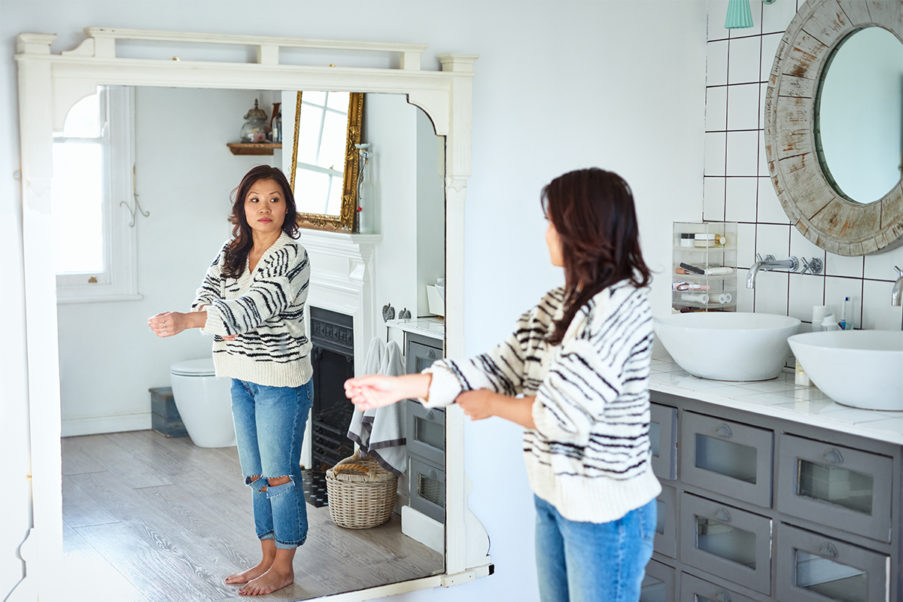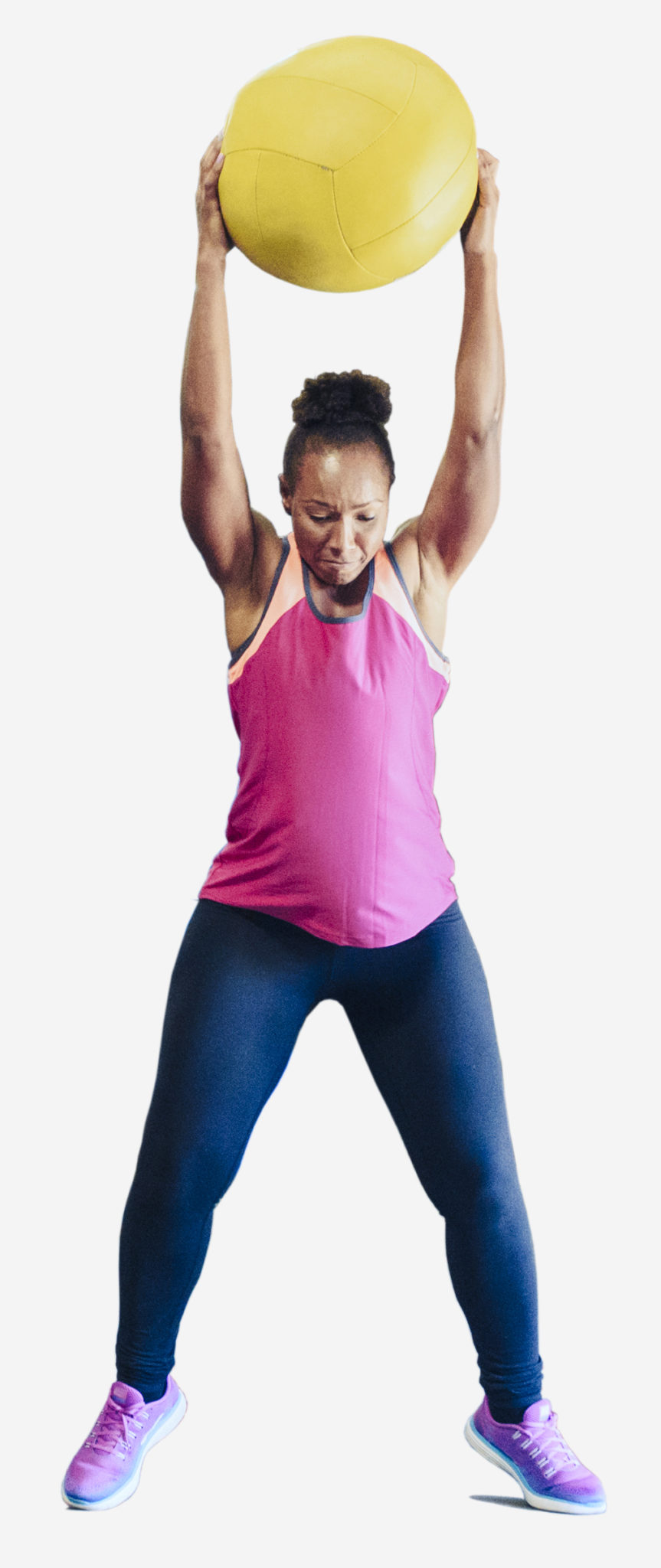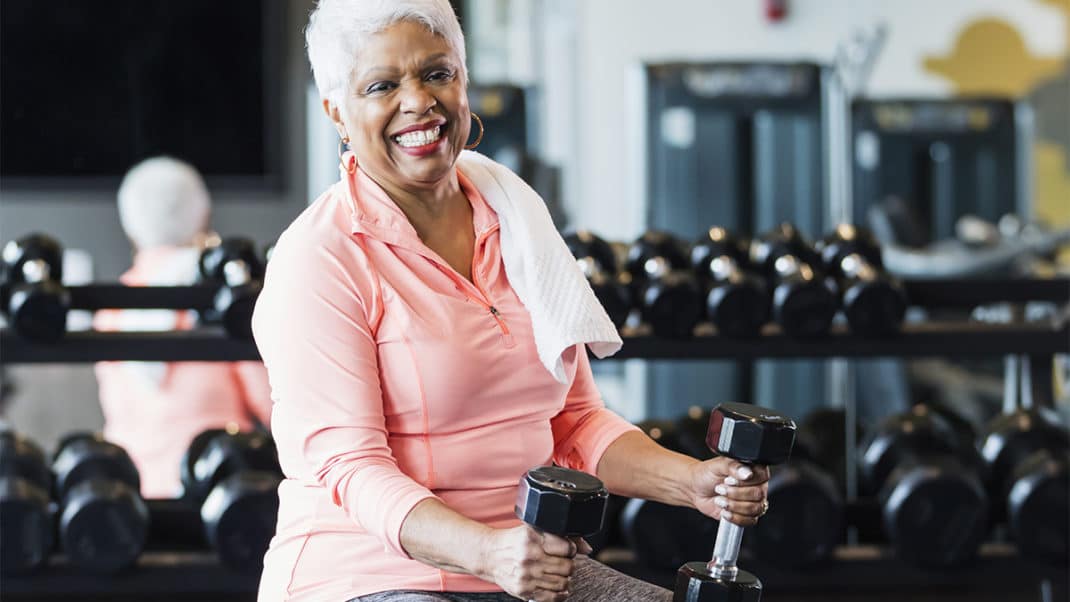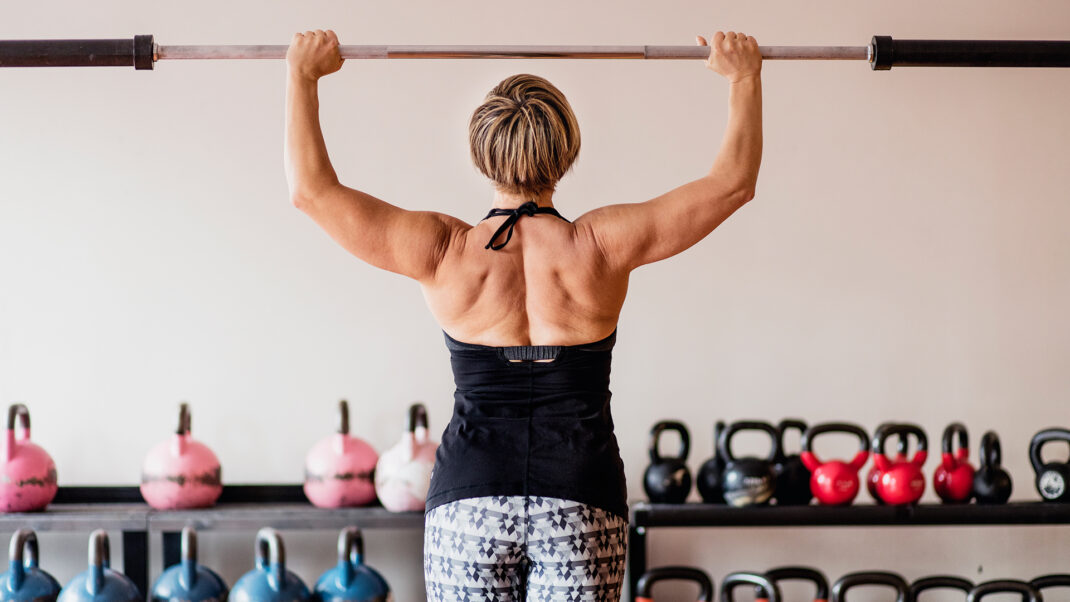Body Image in Menopause
Help clients train through a transition that responds well to targeted, thoughtful programming.

During menopause, women experience a hormonal shift that can often be detrimental to their quality of life and body image. Physical changes in appearance, such as graying hair and wrinkles, are a normal part of aging. But during menopause, the challenges go beyond the purely physical aspects.
Typical age-related changes are often exacerbated by menopause symptoms such as hot flashes, musculoskeletal issues, insomnia and weight gain, particularly in the abdominal area. Additionally, cognitive changes—such as memory loss and brain fog, combined with an increased risk for anxiety and depression—add to the aesthetic changes and can negatively impact women’s psychological health and how they view their bodies.
Studies have shown that the majority of middle-aged women report being dissatisfied with their bodies, with 62% reporting that their weight negatively affected their lives. As few as 12% of women are satisfied with their bodies (Marshall, Lengyel & Utioh 2012; Cameron et al. 2019; Kilpela et al. 2015).
During the menopausal transition, women are at an increased risk for psychological issues such as depression, anxiety and body dissatisfaction, with 45%–68% of perimenopausal women reporting a significant increase in clinical symptoms of depression (Barghandan et al. 2021).
Poor body image in menopause adds additional risk to mental health, with middle-aged women who report being dissatisfied with their bodies experiencing depression nearly twice as much as women who are satisfied with their bodies (Jackson et al. 2014).
Research has continuously shown that body dissatisfaction is an important and persistent issue for most women transitioning through menopause (Cameron et al. 2019).
Considering that an estimated 1.2 billion women worldwide will be menopausal or postmenopausal by the year 2030 (Séjourné et al. 2019), the likelihood is high that fitness professionals will work with this population. The increasing number of women in this group highlights the need for fitness professionals to be more educated about the menopausal transition and the unique and varying challenges that women face during this time.
Menopausal Transition
Menopause is a normal phase in every woman’s life and typically occurs naturally in women between the ages of 44 and 55 (Szymona-Pakowska et al. 2019). However, “menopause” is often used to describe the distinctly different stages in a woman’s life: premenopause, the time when menstruation is normal; perimenopause, when menstruation becomes more infrequent; menopause, when a woman ceases to have a period and has gone 12 months without one; and postmenopause, when the ovaries stop functioning and menstruation has ceased for at least 12 months.
Similar to puberty and pregnancy, the menopausal passage is a milestone in a woman’s life, with changes that can profoundly affect her body image (Séjourné et al. 2019). Menopause symptoms are wide-ranging and are categorized into four groups:
- vasomotor symptoms (night sweats, hot flashes, flushes);
- physical symptoms (body aches, fatigue, migraines, weight gain/increased body mass index, insomnia/sleep problems);
- psychological symptoms (anxiety, mood swings, body image issues, poor memory, depression, cognitive changes); and
- sexual/urogenital symptoms (vaginal dryness and atrophy, painful intercourse, avoiding intimacy, lack of sexual desire).
These manifestations can be very distressing and considerably affect women’s personal, social and work lives, with 30%–40% reporting that menopausal symptoms reduce workplace performance (Monteleone et al. 2018).
The precise cause and underlying mechanisms for the presence and severity of menopausal symptoms are not clearly understood. However, there is accumulating evidence that the complex fluctuations of hormone levels—specifically the fluctuating estrogen levels—are associated with changes within the endocrine, immune and neurologic systems (Pinkerton, Guico-Pabia & Taylor 2010).
In addition, the lower estrogen levels can lead to a host of changes in brain function and behavior, including reduced levels of neurotransmitters such as serotonin, dopamine and oxytocin, which are responsible for cognitive function, mood and memory (Jacobs & D’Esposito 2011).
One of the most bothersome symptoms of menopause and the one most often linked to body dissatisfaction is weight gain, specifically, an unfavorable change in body composition. Even women who have embraced appearance-related changes report being dissatisfied with the weight gain and increase in abdominal fat, with 83% reporting that they dislike their stomach area (Cameron et al. 2019; Lewis-Smith et al. 2016).
The change in hormone levels and a decreased metabolic rate are “associated with weight gain and a redistribution of weight from the lower body to the waist and hip” (Slevec & Tiggemann 2011). The average weight gain for women ages 40–55 is 2.1 kilograms (4.6 pounds) over 3 years. This increase seems to be attributable to the effects of normal aging rather than menopause, but the redistribution of body fat does appear to be menopause-related (Monteleone et al. 2018).
Research shows that although weight and BMI climb steadily during menopause and perimenopause, it appears to stabilize during postmenopause, indicating that menopause-related weight gain is temporary (Greendale et al. 2019; Slevec & Tiggemann 2011).
These physical changes, particularly the increase in body fat in the abdominal area, can change how women see themselves, creating a conflict between the body they perceive as ideal and their actual body. This perception can have negative consequences on health and quality of life (Medeiros de Morais et al. 2017).
Body Dissatisfaction and Body Image in Menopause
Szymona-Pakowska et al. state that “body image encompasses our beliefs about our own appearance (actual self), desired appearance (ideal self), and what the body should look like (ought self).” In essence, body image includes how we see ourselves and how we feel about what we see. Body dissatisfaction falls under the body image umbrella but is further defined as the negative evaluation of how a person sees herself. According to Marshall, Lengyel & Utioh (2012), “approximately 80% of middle-aged women and over 60% of older women report being dissatisfied with their body” and “the majority (76%) were preoccupied with a desire to be thinner and 30% were fearful of becoming ‘too fat’.”
Of particular importance to the concept of body image is just how powerful perception can be. For example, even when women fall in the “normal” weight category, a majority express a desire to be thinner, and those who underperceive their weight have fewer depressive symptoms (Kilpela et al. 2015; Simbar et al. 2020).
Although body image can be a persistent, lifelong issue for women, it is essential to note that similarly to body weight and BMI, menopausal body image issues seem to decline during postmenopause. Evidence suggests that postmenopausal women don’t attach as much importance to physical appearance but instead evaluate their bodies in terms of health and ability (Cameron et al. 2019; Séjourné et al. 2019). Szymona-Pakowska et al. state that “This means that over time the perception of one’s body and its acceptance evolve.”
This knowledge can be of great value for fitness professionals, who can develop motivational strategies to bridge this temporary phase in a woman’s life. Being able to see a conclusion can often be the one piece of knowledge someone needs.
Body Dissatisfaction and Disordered Eating

Eating disorders go hand in hand with body image issues. Body dissatisfaction and aging anxiety have been identified as the most potent risk factors for the development of disordered eating among middle-aged women (Slevec & Tiggemann 2011; Medeiros de Morais et al. 2017). Understanding this can help fit pros recognize initial warning signs, and it’s an opportunity for interventions before disordered eating develops.
Several studies showed that women in midlife regularly think about and engage in disordered eating. In one study, 11% of 42- to 55-year-old women reported regularly binge eating, while 13.4% reported fasting or eating very little in an attempt to regulate their weight (Lewis-Smith et al. 2016).
Kilpela et al. (2015) also reported that 56% of women felt it was appropriate to restrict food intake to prevent weight gain. Considering that there is a correlation between body image, disordered eating and mood disorders, it is essential to note that diagnosing and treating any of these conditions is not within the scope of practice for fitness professionals. If you suspect that a client shows severe symptoms of body dissatisfaction, depression, anxiety or disordered eating, approach them confidentially and advise them to consider consulting a qualified health professional.
Body Image Interventions
Although most interventions with a high success rate are based on therapeutic models such as cognitive behavioral therapy, physical activity interventions have also been shown to play a significant part in helping women improve body image in menopause.
In a review of interventions, Lewis-Smith et al. found that physical activity interventions included dance, yoga, walking, and walking plus action planning. Previous studies have also established walking as a successful intervention for mental health outcomes related to anxiety and depression, which, as previously mentioned, are closely related to body image disorders (Elavsky & McAuley 2007; Hu et al. 2017).
Additionally, strength training has been consistently shown to improve body image and body composition. Feeling stronger and more capable is a positive reinforcer, and it can be very empowering to be able to do things you once weren’t able to do. Seguin et al. (2013) state that “Strength training was associated with significant improvements in several dimensions of body image, health-related quality of life, and physical activity behaviors and satisfaction.”
At the same time, Hausenblas & Fallon revealed that a combination of both aerobic and anaerobic exercise is associated with the best possible outcome regarding body image. The results they describe seem to fall in line with research that highlights the mental health benefits of walking (Seguin et al. 2013; Hausenblas & Fallon 2006; Bondarev et al. 2021).
From an intensity perspective, studies indicate that a higher level of physical activity appears to be the most beneficial for mental health outcomes and body composition (Bondarev et al. 2021; Bondarev et al. 2020; Maillard et al. 2016). Specifically, high-intensity interval training twice a week seems to be more effective in reducing central obesity when compared to moderate-intensity training (Maillard et al. 2016).
Considering that increased body fat in the abdominal area is highly correlated with body dissatisfaction, it’s a good idea for personal trainers to include high-intensity interval training in their programs, as the reduction in body fat could improve body image in menopause.
A bonus: Research also indicates that women tend to report higher levels of satisfaction and enjoyment after continued participation in a strength training program, with a higher level of adherence and participation after starting a program (Seguin et al. 2013).
Implications for Fitness Professionals

The menopausal transition can be highly challenging for women, who are often puzzled by the changes in their body and the shifts in mood, sleep, body and memory. These changes and symptoms can significantly affect women’s body image in menopause, which can negatively impact their motivation to be physically active.
Kilpela et al. found that women report not wanting to participate in activities they enjoy because they perceive themselves as being “too fat.” This can lead to middle-aged clients discontinuing fitness services or not even considering them at all. Fitness professionals can help women change how they view their bodies by being knowledgeable about the possible impact the menopausal transition can have and implementing strategies designed to improve body image within this population.
Certified personal trainer and author of Menopocalypse (Greystone Books 2020), Amanda Thebe has this advice for fitness professionals: “Women are so much more than how they look, and the focus needs to change. There is a growing movement in the fitness world to show women that aging and menopause can be liberating. That women can do hard things and still achieve their goals. That fitness and strength look different on everyone, and how women should harness their strength without being hung up on small imperfections.”
When working with menopausal women who have body image issues, the main point is to focus on including enjoyable activities that boost body image, such as walking, strength training and high-intensity interval training. Include exercises that help women see their bodies less from an appearance perspective and instead help them notice the functional benefits. Provide support and guidance that help them embrace the changes and the possibilities that emerge rather than focusing on what they perceive they have lost.
Sample HIIT Workout
Try the following program design with your menopausal client.
Start with a 5-minute walking warmup on the treadmill. Perform each of the following exercises back to back; 20 seconds on/10 seconds off. Rest for 1 minute between rounds, and perform four rounds total. The intensity for each 20-second interval should be very high.
Interval 1
burpee or modified burpee
20 seconds high intensity; take a 10-second break and move on to next exercise.
Intervals 2 and 3
single-leg lunge and biceps curl
20 seconds high intensity; take 10-second break, switch legs and arm and repeat. Take another 10-second break and move on to next exercise.
Interval 4
ball slam
20 seconds high intensity; take a 10-second break and move on to next exercise.
Intervals 5 and 6
side lunge with single-arm shoulder press
20 seconds high intensity; take a 10-second break, switch legs and arm and repeat.
Take a 1-minute break and repeat the entire round three more times.
Remember to cool down.
Understanding Perceptions and Motivations
It’s important for fitness professionals to know that exercising for weight control, appearance and attractiveness is associated with increased body dissatisfaction, disordered eating behaviors and lower self-esteem (Vartanian, Wharton & Green 2012). This highlights the need for programming that focuses on performance-based outcomes rather than weight loss. Therefore, it is essential to consider their perception of body changes when working with middle-aged women.
To better understand your client’s perceptions and motivations, it is of utmost importance to include specialized open-ended questions, such as asking them about their non-weight-related goals and what types of exercises are most enjoyable to them. Examples include:
- “What makes you feel comfortable and less self-conscious while working out?”
- “Can you describe a fitness goal that you’ve always had that has nothing to do with weight? How might reaching that goal make you feel?”
- “How might being stronger make your daily life a bit easier and more fun?”
These questions can help your client change the focus and evoke thought. The goal is to shift attention away from weight and body size. Help your clients set goals that are measured by what they can do rather than how much weight was lost or how they look. Celebrate performance milestones, such as doing five pushups if they weren’t able to do one when they started training with you.
When you attach positive reactions and feelings to non-weight-related accomplishments, you will slowly but surely reprogram the brain to see success as something other than weight loss. Another vital component is to help your clients recognize and stop negative self-talk. In my own work with clients, I like to create a “judgment-free zone” where fat and old talk is not allowed.
For example, I once had a client who would make comments such as, “I can feel my fat jiggle when I do jumping jacks” and “I hate how I can feel my belly fat when we do this exercise, and it’s gross.” I used this moment to refocus the conversation on things she could now do that she wasn’t able to do when we first started working together. I said, “Remember when you weren’t able to do the exercise because you were too weak or uncoordinated? Isn’t it amazing how far you’ve come? You’re lifting more weight and you’re able to do more difficult movements!”
The goal is to change the way the client looks at movement and shift the topic from appearance to capability.
Factors Associated With Body Dissatisfaction
According to Kilpela et al. (2015), there are five specific psychological factors associated with body dissatisfaction in older women: (1) thin-ideal internalization; (2) cultural perspectives on aging and aging anxiety; (3) self-objectification; (4) importance of appearance; and (5) fat talk and old talk.
Thin-Ideal Internalization
This factor refers to the “extent to which an individual cognitively ‘buys into’ socially defined ideals of attractiveness” (Slevec & Tiggemann 2011). Women who internalize the thin ideal often end
up overmonitoring their bodies. In a sample study of more than 1,800 women over the age of 50, 40% reported that they check their body shape or size daily and weigh themselves regularly (Lewis-Smith et al. 2016). Women with high levels of thin-ideal internalization report increased body dissatisfaction due to the virtual unattainability of the thin body promoted to be “ideal.” Women are told that to be thin is to be attractive, “which counters the biological tendency to gain weight with age” (McKinley & Lyon 2008).
Cultural Perspectives on Aging and Self-Objectification
Culture shapes how women view their bodies. According to McKinley & Lyon, “cultural constructions of femininity include the objectification of women’s bodies, in which women are valued for their appearance.”
Women learn from an early age that their body is viewed as a sexual object and often internalize that belief, which is known as self-objectification. They appraise the value of their body in terms of how attractive others will view them, and high value is given to bodies that are thin and “forever youthful.” This leads to a general acceptance that disliking their body is a normal part of everyday life and efforts to modify their appearance are “normal.”
Lewis-Smith et al. state that “women aged 40–54 years are the largest consumer group of cosmetic surgery in the United States.” The physical changes that are a part of typical aging cause women to constantly move farther away from the socially constructed “ideal body,” and body dissatisfaction can increase (Marshall, Lengyel & Utioh 2012; Slevec & Tiggemann 2011). Not only do women experience immense pressure to be thin, but they also are expected to maintain a youthful appearance; and because youth is equated with attractiveness, aging is often perceived to be synonymous with being less attractive. The perceived loss of attractiveness can make women feel pessimistic about the menopausal transition, which is linked with poor body image. Erbil (2018) stated that 54.1% of women in menopause had a negative attitude about their experience and that women who have a more positive attitude toward menopause had a higher body image. The fact is, the body changes that occur during menopause are standard. Still, the continuous attack of mass media messages stigmatizing aging, indicating that the goal should always be thinness and youthfulness, is challenging to ignore.
Importance of Appearance
Accepting the aging body in a society that promotes youthfulness is not an easy feat, especially when older women who are considered attractive are praised primarily for not looking old (Cameron et al. 2019; McKinley & Lyon 2008). As a result, many women feel disconnected from their bodies because they don’t feel old but are told by society that they look old. This leads them to feel pressured to change their appearance in order to reach the “ideal image” and to believe that doing so is a natural part of aging in today’s society (Cameron et al. 2019).
Marshall, Lengyel & Utioh say that women’s “concerns about aging and weight gain have been exploited by advertisers through the continued use of youthful models, the promotion of products that promise revitalization, and the underlying message that the perfect body is within reach, given the right amount of effort, willpower and financial investment.”
Fat Talk and Old Talk
The terms “fat talk” and “old talk” refer to conversations that implicitly or explicitly promote the thin or youthful ideal (Kilpela et al. 2015). Although these terms typically refer to women who are actively participating in the conversation, there’s also evidence showing that in middle-aged women, weight-related teasing in childhood and negative comments from friends and partners received in adulthood can lead to poor body image in the present (Slevec & Tiggemann 2011).
References
Barghandan, N., et al. 2021. Association of depression, anxiety and menopausal-related symptoms with demographic, anthropometric and body composition indices in healthy postmenopausal women. BMC Women’s Health, 21 (1): 192.
Bondarev, D., et al. 2020. The role of physical activity in the link between menopausal status and mental well-being. Menopause, 27 (4), 398–409.
Bondarev, D., et al. 2021. Associations of physical performance and physical activity with mental well-being in middle-aged women. BMC Public Health, 21 (1), 1448.
Cameron, E., et al. 2019. The female aging body: A systematic review of female perspectives on aging, health, and body image. Journal of Women & Aging, 31 (1), 3–17.
Elavsky, S., & McAuley, E. 2007. Physical activity and mental health outcomes during menopause: A randomized controlled trial. Annals of Behavioral Medicine, 33 (2), 132–42.
Erbil, N. 2018. Attitudes towards menopause and depression, body image of women during menopause. Alexandria Journal of Medicine, 54 (3), 241–46.
Greendale, G.A., et al. 2019. Changes in body composition and weight during the menopause transition. JCI Insight, 4 (5), e124865.
Hausenblas, H.A., & Fallon, E.A. 2006. Exercise and body image: A meta-analysis. Psychology & Health, 21 (1), 33–47.
Hu, L., et al. 2017. Benefits of walking on menopausal symptoms and mental health outcomes among Chinese postmenopausal women. International Journal of Gerontology, 11 (3), 166–170.
Jackson, K.L., et al. 2014. Body image satisfaction and depression in midlife women: The Study of Women’s Health Across the Nation (SWAN). Archives of Women’s Mental Health, 17 (3), 177–87.
Jacobs, E., & D’Esposito, M. 2011. Estrogen shapes dopamine-dependent cognitive processes: Implications for women’s health. The Journal of Neuroscience, 31 (14), 5286–93.
Kilpela, L.S., et al. 2015. Body image in adult women: Moving beyond the younger years. Advances in Eating Disorders, 3 (2), 144–64.
Lewis-Smith, H., et al. 2016. A systematic review of interventions on body image and disordered eating outcomes among women in midlife. International Journal of Eating Disorders, 49 (1), 5–18.
Maillard, F., et al. 2016. High-intensity interval training reduces abdominal fat mass in postmenopausal women with type 2 diabetes. Diabetes & Metabolism, 42 (6), 433–41.
Marshall, C., Lengyel, C., & Utioh, A. 2012. Body dissatisfaction among middle-aged and older women. Canadian Journal of Dietetic Practice and Research, 73 (2), e241–48.
McKinley, N.M., & Lyon, L.A. 2008. Menopausal attitudes, objectified body consciousness, aging anxiety, and body esteem: European American women’s body experiences in midlife. Body Image, 5 (4), 375–80.
Medeiros de Morais, M.A., et al. 2017. Does body image perception relate to quality of life in middle-aged women? PLOS ONE, 12 (9).
Monteleone, P., et al. 2018. Symptoms of menopause—global prevalence, physiology and implications. Nature Reviews Endocrinology, 14 (4), 199–215.
Pinkerton, J.V., Guico-Pabia, C.J., & Taylor, H.S. 2010. Menstrual cycle-related exacerbation of disease. American Journal of Obstetrics & Gynecology, 202 (3), 221–31.
Seguin, R.A., et al. 2013. Strength training improves body image and physical activity behaviors among midlife and older rural women. Journal of Extension, 51 (4).
Séjourné, N., et al. 2019. Body image, satisfaction with sexual life, self-esteem, and anxiodepressive symptoms: A comparative study between premenopausal, perimenopausal, and postmenopausal women. Journal of Women & Aging, 31 (1), 18–29.
Simbar, M., et al. 2020. Is body image a predictor of women’s depression and anxiety in postmenopausal women? BMC Psychiatry, 20 (202).
Slevec, J.H., & Tiggemann, M. 2011. Predictors of body dissatisfaction and disordered eating in middle-aged women. Clinical Psychology Review, 31 (4), 515–524.
Szymona-Pakowska, K., et al. 2019. Body image in perimenopausal women. Menopause Review, 18 (4), 210–16.
Vartanian, L.R., Wharton, C.M., & Green, E.B. 2012. Appearance vs. health motives for exercise and for weight loss. Psychology of Sport and Exercise, 13 (3), 251–56.
Maria Luque, PhD, MS, CHES
Maria Luque, PhD, is a health educator, fitness expert, presenter, writer and USAF veteran. She created Fitness in Menopause, a company dedicated to helping women navigate the challenges and rewards of menopause. Her course “Menopausal Fitness: Training the Menopausal Client” is NASM-, AFAA- and ACE- accredited. She holds graduate and postgraduate degrees in health sciences and teaches at the College of Health and Human Services at Trident University International.







